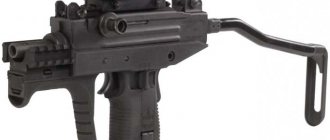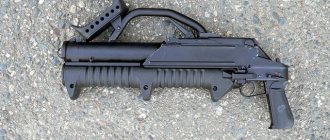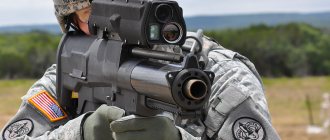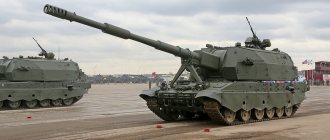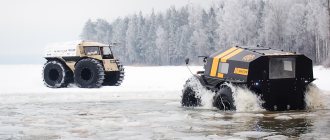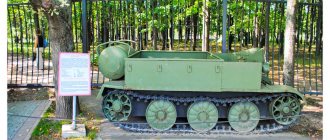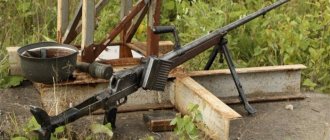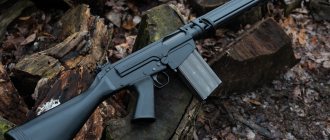Design of the MG-42 machine gun
Having examined the drawings of the MG-42 machine gun, we can identify a number of main parts. These are such important components as the receiver with the barrel, the butt and butt plate, the bolt, the recoil spring, the barrel casing, the trigger mechanism, the box with a lid, the fuse, the charging handle, the locking rollers and the combat cylinder.
The MG-42 machine gun fired with the most common rifle cartridge in Germany at that time - 7.92x57 mm, which could be equipped with a light or heavy bullet. The shooting was carried out exclusively in bursts, because only automatic fire was possible.
Lewis light machine gun (USA - UK)
American Isaac Lewis developed his light machine gun around 1910, based on an earlier machine gun design by Dr. Samuel McLean. The machine gun was proposed by the designer for arming the American army, but in response there was a harsh refusal (caused by a long-standing personal conflict between the inventor and General Crozier, then head of the US Army Weapons Department). As a result, Lewis sent his steps to Europe, to Belgium, where in 1912 he founded the company Armes Automatiques Lewis SA to sell his brainchild. Since the company did not have its own production facilities, the order for the production of the first
Modifications
MG 34/41
MG 34/41 appeared as a result of understanding the experience of the first real battles of the beginning of World War II, when it became clear that an increase in the rate of fire leads to greater dispersion over the area. The rate of fire for the MG 34/41 was increased to 1,200 rounds per minute (for the MG 34 the rate of fire was 800-900 rounds). The weight of the MG 34/41 has increased slightly (14 kg) compared to the original (12.1 kg). A limited production of this modification was made; 300 copies of the machine gun were sent to the Eastern Front. In field tests, the MG 34/41 performed worse than the MG 39/41, which was later designated MG 42.
MG 34T
A modification for installation on tanks, the main difference of which was a heavier, non-perforated casing.
MG-81
MG 81
— 7.9 mm aircraft machine gun.
Developed by Mauser on the basis of the MG 34 infantry machine gun in 1939. The development was aimed at reducing the cost of production and the possibility of use on aircraft as a defense weapon mounted on a movable machine. For these purposes, changes were made to the design to allow the tape to be fed from any side. There was also a modification of the MG-81Z, consisting of two machine guns with a combined trigger (the Z index comes from the German zwilling
,
double
).
Application of MG.42
MG.42 - the main German machine gun of the final stage of World War II. This weapon was known for its reliability, simplicity and durability. We can confidently say that in this case, simplifying the design only benefited the weapon.
In addition to general simplification, many changes were made to the design of the machine gun due to experience in using the MG.34. The gaps between parts were increased, which made the weapon much more reliable; the large charging handle and lid latch made it possible to operate them even with warm gloves. A special “winter” trigger was developed, which also made it possible to fire while wearing mittens.
MG.42 was less demanding on the quality of lubricant, its disassembly and maintenance were easier. Germany trained a huge number of machine gunners for its armed forces (by the end of the war their number was more than 400 thousand people).
However, the main feature of this weapon was its rate of fire. The machine gun could fire from 1200 to 1500 rounds per minute. Although the dispersion at such a high rate of fire is quite significant, it is not critical. The vibration and recoil of the MG.42 does not interfere with its controllability and does not cause any particular complaints.
As a rule, the crew of a machine gun consisted of the first and second numbers, they were also accompanied by a shooter, as well as an ammunition carrier.
It should be noted that German field tactics of that time were largely built around a single machine gun. If the Americans and the British put the rifleman at the forefront, then in Germany the main thing was the machine gunner. In the German army the number of machine guns was maximum, most of which were MG.42.
The MG.42 crew could create a continuous fire barrier through which the attackers simply could not break through. This leaden rain was interrupted only while the barrel was being replaced. American and British soldiers were specially trained to hide from MG.42 bursts and advance while changing the barrel. The psychological impact of this machine gun's fire on enemy soldiers was very great. The Americans released a special training film on how to cope with shock after being under MG.42 fire.
The Americans and British called this machine gun “Hitler’s circular gun,” and the Soviets called it “lawn mower,” “widowmaker,” and “bone cutter.” The Germans themselves nicknamed the MG.42 “Hitler’s saw.” Based on these names, one can imagine its deadly effectiveness. The characteristic roaring sound of this weapon brought real terror to enemy soldiers.
Another unique feature of the MG.42 was the Tiefenfeuerautomat, or depth-of-fire automat. If the machine gunner assumed that his target was approximately 1,500 meters away, he could adjust the weapon to aim (and fire) from 1,300 to 1,700 meters and back. While the weapon was firing, the fire was conducted precisely in this range.
The MG.42 could not conduct single fire, and for a machine gunner a good indicator was the ability to fire bursts of three to five rounds. The German army had strict regulations on how to shoot the MG.42. It was forbidden to fire more than 250 rounds in one burst; the rate of fire at which 300-350 rounds were fired per minute was considered optimal. Similar instructions were introduced to reduce barrel wear and increase the weapon's accuracy.
To summarize the above, we can conclude that the MG.42 is indeed the best single machine gun of the Second World War. The simplification, which was caused by a lack of resources in Germany, not only did not worsen the characteristics of the machine gun, but on the contrary, made this weapon even more reliable and effective. MG.42 proved this both in the sands of North Africa and in the snows of the Eastern Front. This is precisely what can explain the fact that modifications of the MG.42 are still in service.
Story
The 7.9 mm MG 34 machine gun was developed by the German company Rheinmetall-Borsig AG for the Wehrmacht. The development of the machine gun was led by Louis Stange, however, when creating the machine gun, the developments of not only Rheinmetall and its subsidiaries, but also other companies, such as Mauser, were used. The machine gun was officially adopted by the Wehrmacht in 1934 and until 1942 it was officially the main machine gun not only of the infantry, but also of the German tank forces. In 1942, instead of the MG 34, the more advanced MG 42 machine gun was adopted, but production of the MG 34 did not stop until the end of World War II, as it continued to be used as a tank machine gun due to its greater adaptability to this compared to the MG 42.
After the war, the MG 34 was produced in huge quantities and was in service for a long time in the following countries: the USA, Germany, East Germany, Yugoslavia, Czechoslovakia, France, Turkey and Switzerland (M-53 variant), including for NATO standard ammunition (7, 62 and 7.5 mm). In addition, large quantities (tens of thousands of units) were exported and supplied to the USA, Germany and the USSR (mostly captured and restored) to the countries of the Middle East, as well as China, Iran, Iraq, Egypt and Israel.
The MG 34 is primarily worthy of mention as the first single machine gun ever adopted. It embodied the concept of a universal machine gun, developed by the Wehrmacht from the experience of the First World War, capable of performing the role of both a light light machine gun used from a bipod and an easel machine gun used from an infantry or anti-aircraft machine gun, as well as a tank gun used in twin and separate installations of tanks and combat cars Such unification simplified the supply and training of troops and ensured high tactical flexibility.
